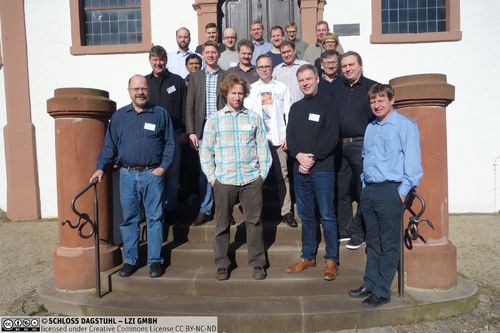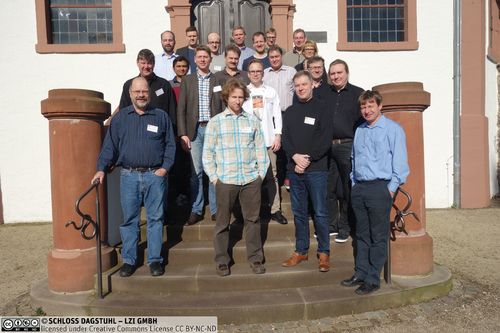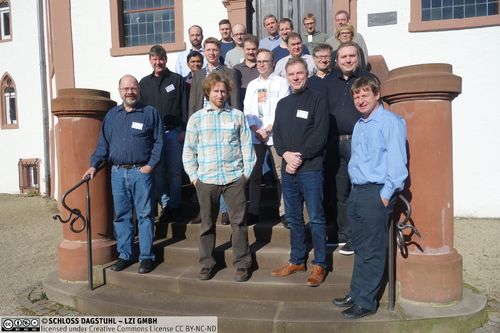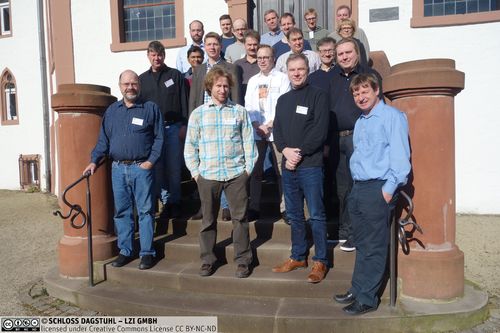Dagstuhl Seminar 17132
Opportunities and Risks of Blockchain Technologies
( Mar 26 – Mar 29, 2017 )
Permalink
Organizers
- Roman Beck (IT University of Copenhagen, DK)
- Christian Becker (Universität Mannheim, DE)
- Juho Lindman (University of Göteborg | Chalmers UT, SE)
- Matti Rossi (Aalto University, FI)
Contact
- Annette Beyer (for administrative matters)
Schedule
Blockchain-based applications such as Bitcoin or Ethereum are emerging technologies, but a dramatic increase in industrial and academic interest in the technology is evident. Start-‐ups and large financial players are working intensely on blockchain-based applications, making this one of the most promising drivers of financial innovation. However, the design and implementation of blockchain-based systems requires deep technical know-how;how in various areas, as well as consideration of economic and societal issues.
These opportunities and challenges provide the starting point for the Dagstuhl Seminar where we will analyze and synthesize the current body of knowledge on the emerging landscape of blockchain technologies. We link cryptographic economic systems to already established research streams around trust-related issues in payment systems and digital currencies, and digital asset management.
The seminar aims for creating a research roadmap and prioritized agenda for the international scientific community concerned with investigating blockchain bases developments. The seminar provides a venue to present findings, develop research collaboration and debate the risks and opportunities of blockchain technology and related services. As the seminar is addressing leading edge developments, weespecially encourage studies of innovative services created. We seek research position statements, case studies, and practitioner reports related to blockchain followed by new service development and their implications.
Topics include but are not limited to:
- Actors in blockchain value chain
- Transformation of novel currencies to old currencies
- Standards and interfaces related to blockchain
- New payment and smart contract platforms
- Blockchain developers and communities
- Business model destruction/creation caused by blockchain and smart contracts in general
- Novel approaches to development of blockchain applications
- Legal issues with smart contracts
- Relationship and interplay of open source and blockchain technology
- Challenges of implementing business logics in smart contracts
- Limits of blockchain applications in large distributed transaction systems
- Implications for existing and rise of new business models
 Roman Beck, Christian Becker, Juho Lindman, and Matti Rossi
Roman Beck, Christian Becker, Juho Lindman, and Matti Rossi
Introduction
The Dagstuhl seminar "Opportunities and Risks of Blockchain Technologies" had 21 participants from universities, public institutions, and enterprises. Blockchain is both an information technology as well as an economic innovation. As a technical innovation it is a new version of a distributed transactional database technology, especially suited for decentralized environments of limited or imperfect trust. As an economic innovation it offers novel tools to any problem domain where there exists a need for a reliable record of transactions in a decentralized environment where not all parties, whether humans or machines, can be fully trusted.
Computer scientists have researched key issues of blockchain technologies such as technical availability, tools, standards, and applications that enable these networks. Our seminar aimed to bridge the gap between this research stream and research perspectives from Service Science, Wirtschaftsinformatik, and Information Systems. We brought together a multi-disciplinary group of academic and industry researchers; specifically those working in fields such as open platforms, open source, distributed trust platforms, cryptocurrency tools, as well as the related social and legal challenges.
We set to analyze and synthesize the current body of knowledge on the emerging landscape of blockchain technologies. We linked the emerging phenomenon of cryptographic economic systems to already established research streams around trust-related issues in payment systems, online currencies, and supply chain management through group work and keynotes. We worked on four theme groups:
- Research centers
- Blockchain and Fintech
- Essence and future of blockchain technologies
- Impact/changing institutions
In the following we look at each of these shortly. The full report contains a number of position papers that explore these issues in further detail.
Research centers
The research center work group sought ways of strengthening the European and global research on blockchain. A starting point was a proposal to form a network of similar minded Blockchain experts and research groups across Europe. Several groups from countries such as in Denmark, Ireland, UK, and Switzerland could start as a loosely coupled interest group to work on potential research agendas and teaching curricula. The Blockchain seminar at Dagstuhl can be regarded as the starting point for the formation of the research network. Based on this network, the next step would be to convince funding agencies and industry to write research proposals for the DRAO (Distributed Research Autonomous Organization). The idea of DRAO is that the Blockchain research center should not be just another research center, doing research on Blockchain, but actually should be based on Blockchain, as a distributed autonomous research organization.
Furthermore, the group discussed a proposal for Blockchain teaching and education. This would result in a suite of courses on various areas, possibly as follows:
Computer Science Foundations
- Cryptography, authentication and signature methods.
- Distributed computing, distributed algorithms, understanding of the tradeoffs, consensus protocols
- Distributed systems
- Domain specific languages for contracts and for protocols.
- Large scale software engineering for distributed ledger development, software engineering
- Program analysis and software quality, objective way of verifying properties
Information Systems Economics
- Economic theories on incentive models, auctions and mechanism design (basically game theory insights)
- Inter-organizational, distributed governance and management theories
- Collective economies, reputation and trust management
- Digital Mindset and management of digital personas
- Ethics and critical reflections of Blockchain and societal implications
Information Systems Management and Organization
- Innovation Design: from Blockchain idea to prototype
- Digital Entrepreneurship: from Blockchain prototypes to markets
- Taxation, auditing and integration of Blockchain in organizations
IT Law
- Legal implications of Blockchain, property rights, ownership, responsibilities
Blockchain ans Fintech
Our second worgroup dealt with the relationship between Blockchain and the Fintech industry. The group produced a matrix of different financial and legal functions, tools required to handle those and the potential of Blockchain to replace solutions to these functions.
Essence and Future of Blockchain Technologies
The workgroup on the essence of blockchain technologies set out to understand what forms the core of the technology. Its preliminary definition is that a blockchain implementation should contain First, the data storage that implements a distributed ledger system (DLS), the actual Blockchain, which is the data structure used in DLS is a hash-linked chain of blocks. A block is a collection of transactions that form the ledger. Furthermore, a Consensus Mechanism allowing for (de-)Centralization of power to decide which transactions are valid in the network. The innovative combination of the above mentioned three components give DLS interesting characteristics that we describe in the next section.
Impacts/changing institutions
This workgroup set out to understand the relationship between technical change and social change. It tried chart the relationship of blockchain and institutions. The discussion centered around the resilience of institutions and the need for stop gap measures, which are often provided by quite traditional public infrastructures and legal frameworks. In some cases, institutions will have to put conditions in place to allow blockchain to work (in particular to avoid harm). The idea of Blockchain being able to replace or eliminate trust was a central topic and it was noted that this can be an issue in cases of fraud (e.g. Ethereum fork as an example). The group also discussed who provides stable identifiers and who decides what can be stored in a given ledger. Similarly, the assignment of value and ownership and their control remain important issues that are now seen as tertiary to the technology. Key questions arising from this were:
- How will blockchain solutions that work well in theory or as prototypes function when used as large-scale solutions?
- Are certain groups or communities better suited to adopt blockchain?
Final comments
We believe that despite some hiccups (e.g., DAO fork) blockchain will emerge as an important technological and economical phenomenon. Its key properties and impacts should be studied intensively to allow for new innovations in the financial sector and other areas, where the technology’s affordances promise to create value. The work continues through a manifesto in Business & Information Systems Engineering, a viewpoint in Communications of the ACM, and a special issue in the Journal of the Association for Information Systems.
 Juho Lindman, Roman Beck, Christian Becker, and Matti Rossi
Juho Lindman, Roman Beck, Christian Becker, and Matti Rossi
- Pär Ågerfalk (Uppsala University, SE) [dblp]
- Michel Avital (Copenhagen Business School, DK) [dblp]
- Roman Beck (IT University of Copenhagen, DK) [dblp]
- Christian Becker (Universität Mannheim, DE) [dblp]
- Joseph Bonneau (Stanford University, US) [dblp]
- Marcus Dapp (fortiss GmbH - München, DE) [dblp]
- Peter Eklund (IT University of Copenhagen, DK) [dblp]
- Fritz Henglein (University of Copenhagen, DK) [dblp]
- John Leslie King (University of Michigan - Ann Arbor, US) [dblp]
- Christoph Kreiterling (BaFin, DE)
- Juho Lindman (University of Göteborg | Chalmers UT, SE) [dblp]
- Alberto Montresor (University of Trento, IT) [dblp]
- Christoph Müller-Bloch (IT University of Copenhagen, DK) [dblp]
- Matti Rossi (Aalto University, FI) [dblp]
- Joachim Schrey (Noerr LLP - Frankfurt, DE)
- Gerhard Schwabe (Universität Zürich, CH) [dblp]
- Peter Sestoft (IT University of Copenhagen, DK) [dblp]
- Virpi Tuunainen (Aalto University, FI) [dblp]
- Marella Venkata (Aalto University, FI)
- Roger Wattenhofer (ETH Zürich, CH) [dblp]
- Jesse Yli-Huumo (Aalto University, FI) [dblp]
Classification
- security / cryptology
- society / human-computer interaction
- software engineering
Keywords
- Blockchain
- Trust Networks
- Trust Platforms
- Cryptocurrencies
- Bitcoin





 Creative Commons BY 3.0 DE
Creative Commons BY 3.0 DE
